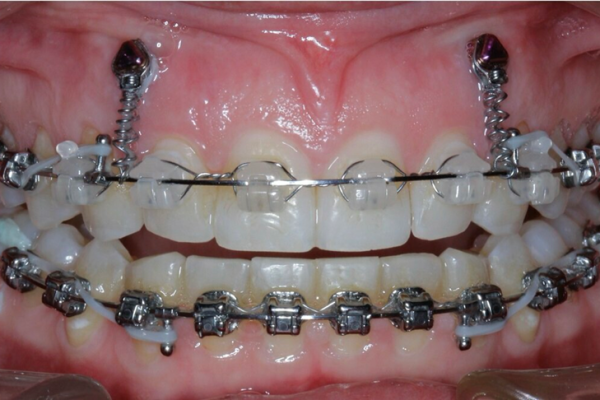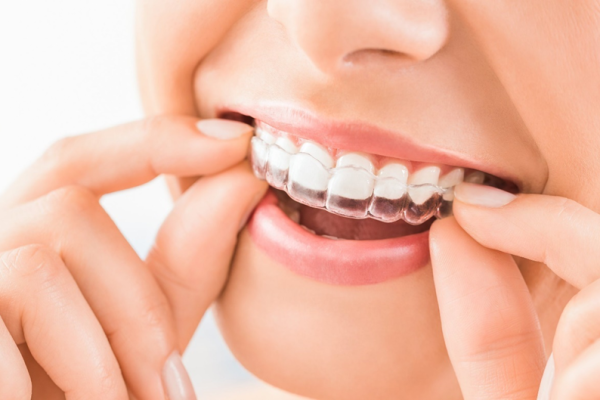

As for the causes of malocclusion, they can be mainly divided into:
For example, if the jaw bone growth pattern and cleft lip and palate are more severe, the orthodontist recommends surgery at the same time.
Many cases requiring orthodontic treatment are still acquired, such as:
Frequent sucking on finger or other foreign objects, may cause the front teeth to grow outwards and require orthodontic treatment
Frequent mouth breathing, can affect the growth of the cheekbones and muscles, resulting in malocclusion and the need for orthodontics
Frequent use of the tongue against the front teeth makes the front teeth more inclined to outgrow, resulting in the inability to bite the front teeth and the need for orthodontics.
Effects of malocclusion
If you have malocclusion but don’t have orthodontics, it can have different consequences, such as:
Teeth are not able to cut and tear food effectively. Greatly affect eating.
Gaps between teeth are unsightly and can cause social distress.
Gaps can also cause pronunciation problems, especially those involving the tongue, which can be difficult to pronounce, and speech can be greatly affected without orthodontics.

Traditional braces consist of metal, ceramic, or reinforced plastic brackets (nails) and wires.
The dentist uses nails and metal attached to the surface of the tooth to apply force to the braces to move the teeth to the target position.
During the procedure, the dentist replaces the metal wires with different characteristics to make detailed adjustments to the braces, so as to accurately control the effect of the braces. Traditional braces can be divided into “external braces” and “internal braces”, the outer braces are fixed to the outside of the teeth, and the price of braces is cheaper than other braces. The internal braces are fixed on the inside of the tooth and are not easy to be noticed, and the internal braces are more difficult to practice, and the price of braces is high, so they are mostly handled by orthodontists.

Detachable and completely transparent invisible braces are a popular choice for braces in recent years.
Unlike traditional braces, which operate with metal wires, invisible braces are transparent and look like retainers, which are essentially braces and are tailored to the shape of the wearer’s teeth. The treatment targets crooked and uneven teeth, which can help to improve problems such as crowded teeth, enlarged gaps, slight malocclusion, and false whistle teeth. Invisalign braces are more comfortable to wear than traditional braces and can be removed at any time.
With this invisible braces, you can remove them and brush and floss your teeth as normal.
And because invisible braces are not metal, the use of invisible braces will theoretically not cause oral damage, and it is much more comfortable than traditional braces. Only the price of braces is higher. For the price of custom-made invisible braces, please contact our clinic.

Invisible braces
Less obvious in appearance: The braces are transparent and look like retainers, which are not easily noticeable in appearance and have less impact on speech.
Easy to clean: After removing the orthodontic braces, you can eat and clean your teeth as usual, and the wearer needs to wear the orthodontic braces for a long time every day. Braces can be removed when eating, brushing or flossing, and new braces need to be replaced every one to two weeks depending on the course of treatment. It is also necessary to take time every day to maintain the hygiene of teeth and orthodontic braces to avoid gum inflammation or tooth decay due to the accumulation of dental plaque.
Less degree of orthodontics: In general, invisible braces are more suitable for cases with less movement or less complexity, and if your case is more complex, the braces dentist has a better chance of recommending traditional braces.
Traditional braces
Visually obvious: Conventional braces consist of metal, ceramic or reinforced plastic brackets (nails) and wires, which are also glued to the tooth surface.
Difficult to clean: Conventional braces tend to get stuck in food debris, so wearers should clean their teeth and braces after meals to prevent food debris and bacteria from endangering the health of teeth and gums. At the same time, traditional braces are relatively difficult to clean and take longer to clean.
Can cause oral damage: As traditional braces involve metal threads or grains on the teeth, they are more likely to cause the ulcers to grow than invisible braces.
Orthodontic treatment: Conventional braces can deal with minor to complex orthodontic problems, and most orthodontic cases can be treated with traditional braces.
If you want to find a braces that works for you, the best way is to consult a doctor. If you have different degrees of tooth alignment or occlusion problems, it is recommended to consult a dentist for orthodontic consultation and listen to the doctor’s professional advice before making a decision. Generally speaking, traditional braces are more suitable for cases with a large range of movement or complexity, and if your case is more complex, the braces dentist is more likely to recommend traditional braces.

Orthodontics is a longer process that is divided into multiple steps.
First of all, we will do a series of data collection, including taking X-rays, photos, etc., and the orthodontist will understand your expectations for orthodontics.
After that, the dentist recommends a treatment plan based on all the information, such as whether orthodontics are needed, what methods to use and how much braces cost.
Once you understand the cost of orthodontics and decide how to use orthodontic treatment, we will make a dental impression for your teeth, using Invisalign as an example, you can clearly see the changes in the displacement of these teeth, and even simulate the changes in the face shape after orthodontics. The doctor will discuss with you the current condition of the whole mouth and the future direction of orthodontic treatment. We will work closely with you throughout the orthodontic process to ensure that you have a good understanding of orthodontics.
Once you have decided on your orthodontic plan, your Invisalign treatment will be finalized, and we will send the data to the original factory in the United States to start making your orthodontic braces.
At your next follow-up visit, you will be able to get your orthodontic braces back and perform other related treatments, such as tooth extraction for orthodontic treatment, and your doctor will guide you to start wearing orthodontic braces.
Finally, regular follow-up visits are required to ensure the progress of orthodontics. The interval of follow-up visits recommended by your braces dentist varies from person to person.

The cost of orthodontic treatment depends on a number of factors. Factors such as the braces used, the difficulty, the materials used, the desired results, and the need for tooth extraction will also affect the final orthodontic cost.
In general, our orthodontic fees range from $30,000 to $40,000 (Invisalign), which may be higher if your case is more complex. Please call 2602-8130 to inquire about the cost of orthodontics.
Our invisible braces use Invisalign, the largest and most clinically data-based Invisalign on the market.

It depends on your situation, the braces method used, the difficulty, the materials used, the results you want to achieve, whether you need to remove your teeth, etc. Generally speaking, it is one to two years.
At present, invisible braces are recommended for mainstream orthodontics, which are more comfortable than traditional braces, and generally make teeth more sensitive but not painful.
In recent years, the mainstream orthodontic treatment recommends not to remove the tooth as much as possible, however, it depends on your situation, please consult a orthodontist for details.
As mentioned above, in view of different conditions such as bony malocclusion, dental malocclusion, etc., which can lead to different dental problems, such as affecting eating, unsightly, causing social distress, etc., mainstream orthodontics recommends the use of different braces to treat malocclusion to ensure your dental health.
Mainstream orthodontics recommends that you wear a retainer after the braces, and if the wearing time is sufficient, the treatment effect can last for a long time.
In general, braces have little effect on the diet, but it is not recommended to eat foods that are too dark to affect their appearance.
The recommended interval between follow-up appointments for mainstream orthodontics varies from person to person and largely depends on the complexity of your orthodontic treatment.
At Oriens Dental & Implant Centre, orthodontic costs are paid in installments to ensure flexibility to suit your needs.
The recommended start time of braces for mainstream orthodontics varies and may vary depending on your condition, please consult us for details.